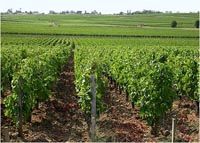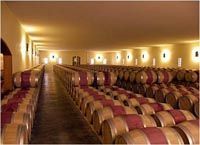 | When Gautreau acquired Sociando-Mallet it was a somewhat dilapidated property. It was perhaps a purchase based on a dream, rather than a more practical business plan. The vineyard had been reduced to just a few hectares of vines, and several buildings were derelict. Not only that, but Gautreau has told me that the locals thought the appended name of Mallet to be at least amusing, if not more. But such thoughts did not deter Gautreau, who obviously had a vision of the potential of the vineyard. Those vineyards that had fallen out of use were ploughed, revealing promising gravelly soils, typical of the vineyards that run along the banks of the Gironde. Gautreau would say it is this terroir, the same band of gravel that runs beneath the vines of Latour and numerous other leading properties of the Médoc, that gives the wines of Sociando-Mallet their fine character. |
| The vineyard and chateau sits right on the Gironde, in the commune of St.-Seurin de Cadourne, just to the north of Saint Estephe. The vineyard is on a gravel croupe that slopes away from the buildings at the top of the estate. The varieties planted are 55% Cabernet Sauvignon and 40% Merlot, the remaining 5% part Cabernet Franc and part Petit Verdot. The vines are planted very densely, and there is no green harvest, thus yields are high even for Bordeaux, with perhaps 80 hl/ha. The harvest is manual, and once in the cuvier the fruit is fermented in both concrete and stainless-steel vats, with temperatures up to 33°C to encourage the extraction of tannins. The wine is then macerated for three weeks, before going into oak, 100% for the grand vin, Chateau Sociando-Mallet (typically 20 000 cases per annum), although in the case of the second wine La Demoiselle de Sociando-Mallet 20% goes into oak and the rest remains in cuve. |  |